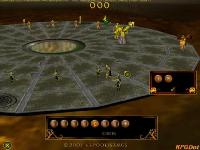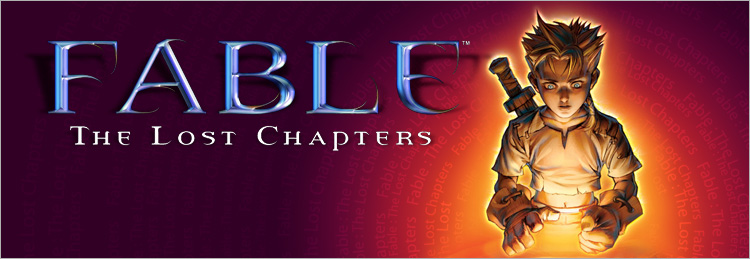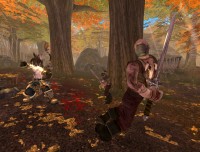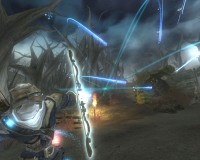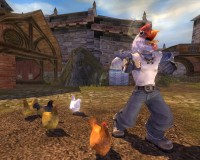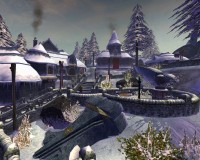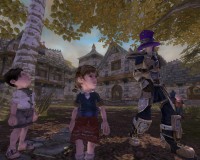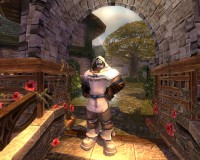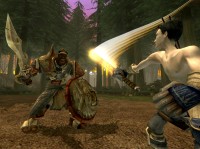|
|
|
Main News Forums Games Games Database Top 100 Release List Support Files Features Reviews Previews Interviews Editorials Diaries Misc Download Gallery Music Screenshots Videos Miscellaneous Staff Members Privacy Statement |
Fable: The Lost Chapters - A Review
It's hard to talk about Fable: The Lost Chapters without mentioning iconic designer Peter Molyneux and some of the infamous claims made during development - it was even going to be the greatest RPG ever. This just isn't that game. With that said, we'll concentrate on what Fable: TLC is, rather than what it isn't. The premise behind Big Blue Box' and Lionhead's game is an RPG where players can live the life of a virtual Hero however they please in the world of Albion, with their actions determining how their character develops - and how the other inhabitants of Albion react to them. In reality, Fable: TLC is a fairly conventional action RPG with good and evil paths that slowly affect the character's appearance (from an angelic halo to demonic horns), some nice NPC behaviours and a handful of fairly shallow options such as getting married. It's bright, simple, humorous and altogether too short. There's no character creation in Fable: TLC, so it's straight into the game as a child in the town of Oakdale - an idyllic village in a land that looks like a colourful slice of English countryside and populated by cartoon folk with thick cockney accents. It's not long before you find yourself at the Heroes Guild, where you are apprenticed to learn the fine art of being one of Albion's Heroes. These segments form an extended tutorial and after undertaking some tasks, you'll graduate a young adult and start your career as an official Hero. Most of the quests in Fable: TLC are obtained at the Guild in the form of Quest Cards - requests lodged with the Guild by the citizens of Albion. Players go to the Map Room and choose one or more Quest Cards, then head off to the locations specified to undertake them. In keeping with the theme of Good vs Evil, some of the quests are available as opposite sides of the same event - protecting some traders from a bandit raid on the one hand; assisting a bandit group as they attack some traders on the other. Apart from these simple moral choices, most of the quests are straightforward combat missions and the Quest Card system is designed to streamline play - you'll never have to figure out where to go next or search for an NPC; just teleport back to the Guild, grab some cards and head off again. While the optional Quest Cards can be taken and completed in any order, the main story-critical quests are strictly sequential, with each one only becoming available when the preceding mission has been completed. Coloured dots mark quest locations on the mini-map plus the paths are well marked with signs, so things are easy to find. Not that players are too likely to get lost in the first place - outside of towns, the world of Fable is constructed of short connected maps, which often consist of a single path. Additionally, most of these paths are hemmed in with rocks, trees or stone fences, keeping players to the straight and narrow. This is one of the Fable: TLC's biggest flaws: it presents an attractive world for players to explore but often you'll simply travel along a narrow path for several maps, punctuated with short load times. Once players enter a quest location, that particular quest has to be completed - you can't save during a quest and leaving the area cancels the quest progress. Combat is really the main substance of Fable: TLC - and it's a pretty solid direct-action model. The left-mouse attacks, middle blocks and the right-mouse is a form of combo attack called a "Flourish". Combat is fast-paced and heavily reliant on player reflexes, often against a small horde of fantasy enemies from bandits to undead. The controls are responsive with a solid feel. Each successful hit without taking damage increases a combat multiplier, which increases the experience gained - in turn, taking a hit lowers the multiplier. Successive hits also enable a Flourish - a slower but unblockable and powerful attack - together these two elements add a little depth to an otherwise straightforward system. For magic users, holding down the left-shift maps two spells to the left and right mouse buttons.
Characters have to return to the Guild to spend the experience points gathered on quests. Fable: TLC uses a classless system based around three attributes: Strength, Skill and Will. These three broadly equate to fighter, rogue and mage related groupings, with each broken down into specific skills that are purchased with XP. The Strength group is Physique, Health and Toughness, for example, while the Will group includes Magic Power and spells in various schools. Experience itself is earned in each of these Attributes - melee weapons earn Strength experience, bows accrue Skill points and using magic adds to the Will pool. There are no levels - players can spend experience points whenever they choose. With this classless system, players can develop their character with any mix of skills they like. In practice, most players will end up developing a melee/magic hybrid - melee is highly effective but lacks different combos (other than the single Flourish) to add variety and deal with crowds - a handful of spells fills this gap nicely. Meanwhile, a primary magic user will find the interface awkward for changing spells and bows are ineffective against large groups of enemies that close in rapidly. In the course of play, you'll encounter a handful of towns and these are definitely one of the highlights. The towns bustle with life and a level of detail rarely seen - townsfolk wander about their business, deliverymen carry boxes of goods to the stores and children frolic with playful antics. As you pass near NPCs they may wave or pass comment; you start the game with the ignominious title of "Chicken Chaser" and passerby will mutter phrases like "Chicken Chaser? What sort of name is that?". As your character develops in stature and alignment, the townsfolk may pass appreciative comments - even applaud - or run screaming as appropriate. Naturally, new equipment can be purchased from the shops and there are some side quests to be found (although surprisingly few), in addition to some mini-games at the taverns. As evening draws, the shops close and everyone wanders home to sleep for the night. Towns are also an opportunity to express your nature by behaving obnoxiously, smashing barrels and stealing - or not, of course. The liveliness of the towns stands in stark contrast to the personality of the NPCs and your ability to interact them. Although there is some very limited dialogue with specific NPCs (essentially those with a quest) there are no dialogue trees other than a fairly rare "yes" or "no", which in turn usually corresponds to a good or evil action. Otherwise, the only interaction is through a series of emotes, such as farting, belching, striking a manly pose and even a Cossack dance, disco dance and crotch grab - yes, you read right. While the NPCs will comment on these actions, that's about all it amounts to. Likewise, the marvellous atmosphere of the towns seems a bit hollow when you realise the NPCs are essentially clones with nothing to say, with the same models and voiceovers repeated time and time again. This style over real substance is highlighted by the option to get married: it takes little more than pressing the "Heart" emote a few times in front of your chosen mate - but which mate? My first play through I chose one with a ponytail and skirt, rather than the short hair and trousers…only because there were less of that model and I might remember which one I was wooing. Other than receiving a small dowry, there's no other impact on the gameplay. In addition to getting married, there are a number of secondary activities to break up the combat. Players can purchase and rent out houses, play a mini-game in the tavern, join a fist-fighting competition, fish or dig for loot (including silver keys, which open chests found over Albion) and more. Customising appearance also plays an important role with haircuts and tattoos, in addition to clothing and armour.
Fable: TLC certainly looks fantastic. The fairy-tale theme is bright and colourful, with soft ambient lighting that suits the setting. The landscapes are particularly attractive, with long grasses swaying on the wind, dense foliage and impressive skies. The animation is top-notch with lots of nice touches such as the slightly goofy guards and kids playing games. The audio is even better with sweeping orchestral music tracks and a huge amount of humorous voice acting. On the other hand, the interface is a mixed bag that includes clear signs of a console port. The main WASD movement control and basic combat works well, along with the well-designed main display but other functions are muddled. Accessing more than two spells in the heat of battle is a pain and some functions share the same keys, which minimises the total number of keys but causes other problems. The various inventory and quest screens use multiple nested menus, obviously designed to be navigated with a gamepad. Ultimately, Fable: TLC is a polished package offering lots of action along side nice graphics and brilliant audio. The story is full of fantasy cliché's - including bloodlines, lost family members and a magic sword - but after a slow start builds some momentum; there's even a couple of rather dark moments that may stir some players. It's clear this game is aimed at a wide audience, many of whom will find the combination of action, developing the appearance of their avatar, simple good vs evil choices and activities like getting married and hunting for silver keys a winning formula. Players looking for more depth will be disappointed that none of these activities have any real impact on the core gameplay, the choices have little consequence, the story and locations relentlessly linear and character interaction is little more than a gimmick. Even fans of other action RPGs like Diablo may be left a little flat, because Fable: TLC doesn't have a high emphasis on addictive elements like lots of loot, gaining levels or deep skill trees. Taking the time to explore thoroughly, including dabbling in all the mini-games and activities yields around 20 hours of play - a run straight through the main story line is probably good for 8-10 hours. With the exception of some of the boss fights, Fable: TLC is also pretty easy, especially given the number of resurrection vials you'll accumulate throughout the game. It's seems odd a game that originally set out to be revolutionary ends up a conventional action adventure with some peripheral curiosities. Still, the action works for the most part, the production values are top-notch and it has a certain charm. It's certainly a pleasant world to spend time in but the lack of real choices and short, easy gameplay may leave seasoned players feeling unsatisfied.
Rate this title and view comments Game Info Printer Friendly Version This is how we rate |
|||||||||||||||||||||||||||||||||||||||||||||||
|
All original content of this site is copyrighted by RPGWatch. Copying or reproducing of any part of this site is strictly prohibited. Taking anything from this site without authorisation will be considered stealing and we'll be forced to visit you and jump on your legs until you give it back. |
||




